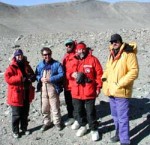McMurdo LTER
McMurdo Dry Valleys LTER site (MCM) enjoys a long and colorful history hosting international investigators, and the tradition continues.
During the 2001-2002 field season two British Antarctic Survey (BAS) scientists, Drs. David Wynn-Williams and M. Roger Worland worked in the Dry Valleys in collaboration with MCM investigators Diana Wall, Peter Doran, and Ross Virginia.
The history of this collaboration began in 1995 when Diana Wall joined a BAS team and a group from an Italian program to study soil biodiversity at Terra Nova Bay, Antarctica. As part of this project Wynn-Williams established a field experiment near Lake Hoare in Taylor Valley, Antarctica to study the effects of UV-radiation on soil cyanobacteria and associated soil invertebrates. Wynn-Williams and Worland sampled these plots again in January 2002 and collected materials for study as part of the BAS LATEST (Life At The Edge; Stresses and Thresholds) Program.
In the LATEST program, they are investigating pigments produced by photosynthetic microbes in stratified communities for protection and adaptation under extreme solar radiation stress; the effect of UVB and UVC on photosynthetic microbes from terrestrial habitats, and; the effects of desiccation, osmotic stress and low temperatures on the viability of polar organisms.
An important aspect of this work is the development and use of a field laser Raman spectroscopy to study the chemical ‘fingerprints’ of microbes actually inside rocks or in mats that exist in the lakes in the Dry Valleys. This work is part of the BAS and NASA exobiology initiatives. After evaluation in Antarctica, a miniature Raman spectrometer is anticipated on a future Mars lander for spatial analysis of buried permafrost profiles that may reveal the presence of any residual biomolecules, especially from former surface photosynthetic life. See the BAS WEB page for further information, http://www.antarctica.ac.uk/Science/Programmes/latest/index.html
This collaboration with the BAS scientists continues a long-term interaction among MCM-LTER scientists and their international collegues. Drs. Johanna Laybourn-Parry, Univeristy of Nottingham, England and Ina Hawes, NIWA, New Zealand have collaborated on Antarctic research for the past four years. In two of the past three field seasons, Dr. Martyn Tranter from the University of Bristol, England, has been a field party member and in the coming season, Dr. Martin Melles, from the University of Leipzig, Germany, will participate. Since 1993 scientists from Great Britain, New Zealand, Canada, Austria, Russia and Germany have been involved with the MCM-LTER.

 Enlarge this image
Enlarge this image